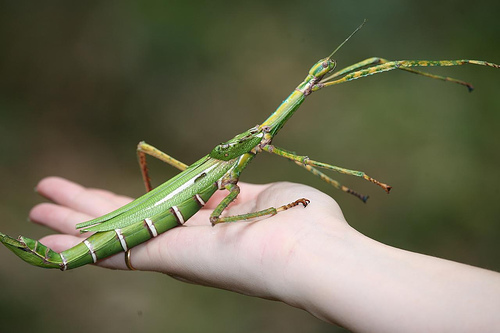Amazing Stick Insect – Phasmida
Stick insects are insects in the order Phasmatodea (or Phasmida). The whole order is camouflaged as either sticks or leaves. Leaf insects are generally the family Phylliidae. They are found in South and southeast Asia to Australia. There are in excess of 3,000 described species, with many more yet to be described, in museum collections and in the wild. Stick insects, like praying mantis, show rocking behaviour in which the insect makes rhythmic, repetitive side-to-side movements. This may help crypsis by resembling vegetation moving in the wind.
As its name suggests, the stick insect resembles the twigs among which it lives, providing it with one of the most efficient natural camouflages on Earth. It and the equally inconspicuous leaf insect comprise the Phasmida order, of which there are approximately 3,000 species.
Stick insect species, often called walking sticks, range in size from the tiny, half-inch-long (11.6-millimeter-long) Timema cristinae of North America, to the formidable 13-inch-long (328-millimeter-long) Phobaeticus kirbyi of Borneo. This giant measures over 21 inches (55 centimeters) with its legs outstretched, making it one of the world’s longest insects. Females are normally larger than males.
Phasmids generally mimic their surroundings in color, normally green or brown, although some species are brilliantly colored and others conspicuously striped. Many stick insects have wings, some spectacularly beautiful, while others resemble little more than a stump. A number of species have spines and tubercles on their bodies.
Found predominantly in the tropics and subtropics—although several species live in temperate regions—stick insects thrive in forests and grasslands, where they feed on leaves. Mainly nocturnal creatures, they spend much of their day motionless, hidden under plants.
Many stick insects feign death to thwart predators, and some will shed the occasional limb to escape an enemy’s grasp. Others swipe at predators with their spine-covered legs, while one North American species, Anisomorpha buprestoides, emits a putrid-smelling fluid.
Little is known about stick insects, making it difficult to declare the vulnerability of their status in the wild. The pet trade presents a potential threat, along with the popular practice of framing their carcasses, like butterflies.
Fast Facts about Stick Insect
Type: Bug
Diet: Herbivore
Average life span in the wild: Up to 3 years
Size: 0.46 to 12.9 in (11.6 to 328 mm)
Weight: Up to 550 lbs (227 kg)
Group name: Bed or knot
Did you know? Stick insects are part of the Phasmida order, the name of which is derived from a Greek word meaning “apparition.”
Courtesy : http://animals.nationalgeographic.com, http://en.wikipedia.org/
Stick Insect Images / Pictures





























